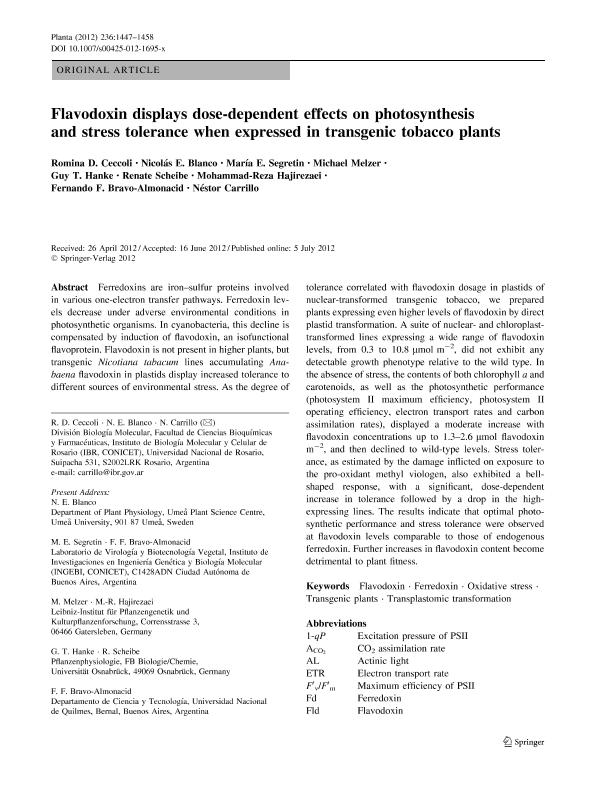Mostrar el registro sencillo del ítem
dc.contributor.author
Ceccoli, Romina Denis

dc.contributor.author
Blanco, Nicolás Ernesto

dc.contributor.author
Segretin, Maria Eugenia

dc.contributor.author
Melzer, Michael
dc.contributor.author
Hanke, Guy T.
dc.contributor.author
Scheibe, Renate
dc.contributor.author
Hajirezaei, Mohammad Reza
dc.contributor.author
Bravo Almonacid, Fernando Felix

dc.contributor.author
Carrillo, Nestor Jose

dc.date.available
2024-03-14T15:34:18Z
dc.date.issued
2012-07
dc.identifier.citation
Ceccoli, Romina Denis; Blanco, Nicolás Ernesto; Segretin, Maria Eugenia; Melzer, Michael; Hanke, Guy T.; et al.; Flavodoxin displays dose-dependent effects on photosynthesis and stress tolerance when expressed in transgenic tobacco plants; Springer; Planta; 236; 5; 7-2012; 1447-1458
dc.identifier.issn
0032-0935
dc.identifier.uri
http://hdl.handle.net/11336/230605
dc.description.abstract
Ferredoxins are iron–sulfur proteins involved in various one-electron transfer pathways. Ferredoxin levels decrease under adverse environmental conditions in photosynthetic organisms. In cyanobacteria, this decline is compensated by induction of flavodoxin, an isofunctional flavoprotein. Flavodoxin is not present in higher plants, but transgenic Nicotiana tabacum lines accumulating Anabaena flavodoxin in plastids display increased tolerance to different sources of environmental stress. As the degree of tolerance correlated with flavodoxin dosage in plastids of nuclear-transformed transgenic tobacco, we prepared plants expressing even higher levels of flavodoxin by direct plastid transformation. A suite of nuclear- and chloroplast-transformed lines expressing a wide range of flavodoxin levels, from 0.3 to 10.8 μmol m−2, did not exhibit any detectable growth phenotype relative to the wild type. In the absence of stress, the contents of both chlorophyll a and carotenoids, as well as the photosynthetic performance (photosystem II maximum efficiency, photosystem II operating efficiency, electron transport rates and carbon assimilation rates), displayed a moderate increase with flavodoxin concentrations up to 1.3–2.6 μmol flavodoxin m−2, and then declined to wild-type levels. Stress tolerance, as estimated by the damage inflicted on exposure to the pro-oxidant methyl viologen, also exhibited a bell-shaped response, with a significant, dose-dependent increase in tolerance followed by a drop in the high-expressing lines. The results indicate that optimal photosynthetic performance and stress tolerance were observed at flavodoxin levels comparable to those of endogenous ferredoxin. Further increases in flavodoxin content become detrimental to plant fitness.
dc.format
application/pdf
dc.language.iso
eng
dc.publisher
Springer

dc.rights
info:eu-repo/semantics/openAccess
dc.rights.uri
https://creativecommons.org/licenses/by-nc-sa/2.5/ar/
dc.subject
FLAVODOXIN
dc.subject
TRANSPLASTOMIC TRANSFORMATION
dc.subject
PHOTOSYNTHESIS
dc.subject.classification
Bioquímica y Biología Molecular

dc.subject.classification
Ciencias Biológicas

dc.subject.classification
CIENCIAS NATURALES Y EXACTAS

dc.title
Flavodoxin displays dose-dependent effects on photosynthesis and stress tolerance when expressed in transgenic tobacco plants
dc.type
info:eu-repo/semantics/article
dc.type
info:ar-repo/semantics/artículo
dc.type
info:eu-repo/semantics/publishedVersion
dc.date.updated
2024-02-22T14:24:50Z
dc.journal.volume
236
dc.journal.number
5
dc.journal.pagination
1447-1458
dc.journal.pais
Alemania

dc.journal.ciudad
Bonn
dc.description.fil
Fil: Ceccoli, Romina Denis. Consejo Nacional de Investigaciones Científicas y Técnicas. Centro Científico Tecnológico Conicet - Rosario. Instituto de Biología Molecular y Celular de Rosario. Universidad Nacional de Rosario. Facultad de Ciencias Bioquímicas y Farmacéuticas. Instituto de Biología Molecular y Celular de Rosario; Argentina
dc.description.fil
Fil: Blanco, Nicolás Ernesto. Consejo Nacional de Investigaciones Científicas y Técnicas. Centro Científico Tecnológico Conicet - Rosario. Instituto de Biología Molecular y Celular de Rosario. Universidad Nacional de Rosario. Facultad de Ciencias Bioquímicas y Farmacéuticas. Instituto de Biología Molecular y Celular de Rosario; Argentina
dc.description.fil
Fil: Segretin, Maria Eugenia. Consejo Nacional de Investigaciones Científicas y Técnicas. Instituto de Investigaciones en Ingeniería Genética y Biología Molecular "Dr. Héctor N. Torres"; Argentina
dc.description.fil
Fil: Melzer, Michael. Leibniz-Institut für Pflanzengenetik und Kulturpflanzenforschung; Alemania
dc.description.fil
Fil: Hanke, Guy T.. Universidad de Osnabrück.; Alemania
dc.description.fil
Fil: Scheibe, Renate. Universidad de Osnabrück.; Alemania
dc.description.fil
Fil: Hajirezaei, Mohammad Reza. Leibniz-Institut für Pflanzengenetik und Kulturpflanzenforschung; Alemania
dc.description.fil
Fil: Bravo Almonacid, Fernando Felix. Consejo Nacional de Investigaciones Científicas y Técnicas. Instituto de Investigaciones en Ingeniería Genética y Biología Molecular "Dr. Héctor N. Torres"; Argentina. Universidad Nacional de Quilmes. Departamento de Ciencia y Tecnología; Argentina
dc.description.fil
Fil: Carrillo, Nestor Jose. Consejo Nacional de Investigaciones Científicas y Técnicas. Centro Científico Tecnológico Conicet - Rosario. Instituto de Biología Molecular y Celular de Rosario. Universidad Nacional de Rosario. Facultad de Ciencias Bioquímicas y Farmacéuticas. Instituto de Biología Molecular y Celular de Rosario; Argentina
dc.journal.title
Planta

dc.relation.alternativeid
info:eu-repo/semantics/altIdentifier/url/https://link.springer.com/article/10.1007/s00425-012-1695-x
dc.relation.alternativeid
info:eu-repo/semantics/altIdentifier/doi/https://doi.org/10.1007/s00425-012-1695-x
Archivos asociados
